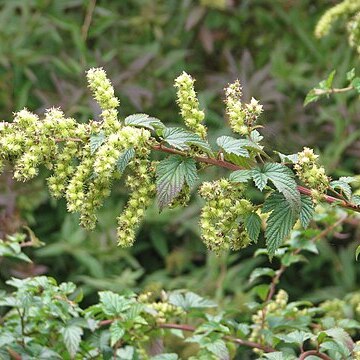Shrubs erect, to 2 m tall. Branchlets red-brown, angled, glabrous to slightly pubescent; buds red-brown, ovoid, with 2 or 3 scales, apex obtuse; often 2 or 3 buds superposed in axils of flowering branches. Stipules ovate-lanceolate, ca. 6 mm, subglabrous, margin remotely serrate, apex acute; petiole 1–1.5 cm, subglabrous; leaf blade ovate to ovate-elliptic, 6–8.5 × 4–6 cm, abaxially sparsely pubescent on veins or subglabrous, base rounded or subcordate, margin usually 3-parted, rarely with 3–5 equal lobes, sharply doubly serrate, apex long acuminate. Panicle 6–15.5 cm in diam., densely or laxly branched, usually many flowered; peduncle and pedicels slightly pubescent. Flowers ca. 4 mm in diam.; pedicel ca. 3 mm. Hypanthium campanulate, 2–3 mm, abaxially pubescent. Sepals triangular, equaling hypanthium, sparsely pubescent on both surfaces, margin entire, apex caudate. Petals white, obovate, ca. 2 mm. Stamens 10–15. Ovary cylindric, glabrous or only pubescent on sutures, or wholly pubescent; ovules (8–)10–12. Follicles cylindric. Seeds ovoid. Fl. Jul, fr. Sep–Oct.
A shrub. It grows to 2 m high. The leaves have stalks. They are alternate. The leaves have 3 leaflets which are oval or sword shaped. They have sharp teeth around the edge. They are hairy on the veins underneath. The flowers are white. They are in open flower clusters in the axils of leaves or at the ends of branches. The fruit are cylinder shaped follicles with oval seeds.


